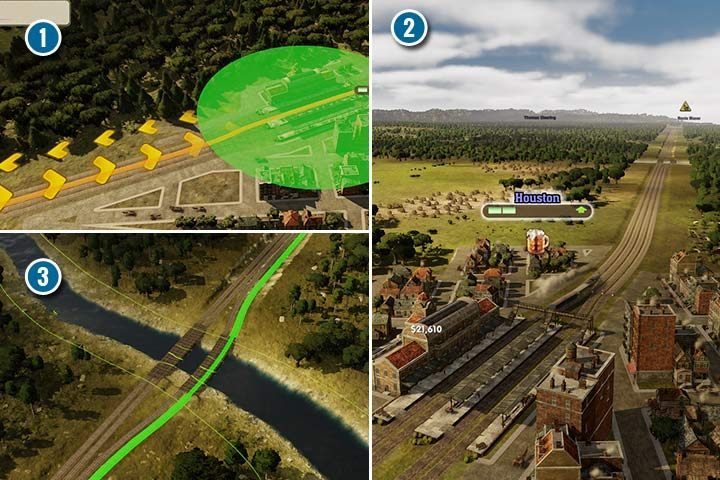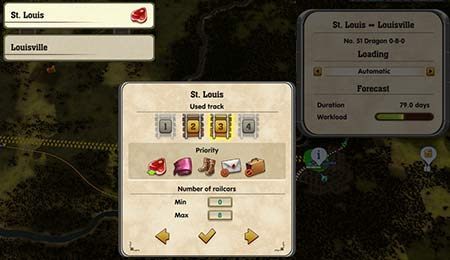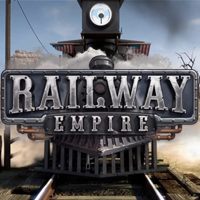Railway Empire: Building tracks and creating lines
Last update:
Creating new connections, connecting cities and production centers by using stations and tracks, that is your daily bread in Railway Empire. The tool for creating new railway sections is very simple, but you have to start a new route from an already existing track, e.g. at the end of a station or at any point in a functional, finished line.

The main problem when building new tracks is dealing with difficult terrain. The game automatically creates the simplest possible connection between two points. At the same time, it creates the necessary embankments, bridges or tunnels. This is a very useful, but also hugely expensive solution. As a result, you have the shortest possible route with a minimal gradient. Bridges and tunnels can be very expensive, and it is best to avoid expensive connections in the first stages of each scenario. Place tracks where the terrain favors them - that is, where the land is flat and vast. If you need to build, e.g. a bridge, try to put it in a very convenient place, such as over a river or a ravine, and then configure a larger amount of connections to use it, in order to spend your money efficiently.
When building tracks, add reference points to have more impact on the direction of the route. This way, you can use the natural shape of the terrain and avoid the construction of expensive structures. This is done at the expense of the gradient of the route. Trains will move around slower on such sections, so it is worth assigning powerful locomotives to compensate for this. Otherwise, the journey on such a route will take more time. Additional points will also be useful when planning complicated connections.
When creating new connections, it is worth to put tracks in such a way, that they coincide with the goods that will be transported. Speed ??is important for transporting passengers and mail, so the tracks should be straight, on flat terrain, with as few turns as possible and with minimal differences in altitude. This way, the train will reach its goal very quickly. Traditionally, freight trains are slower (the engines are slower and the freight wagons are heavier), so you do not have to create such convenient routes. However, when transporting goods, the speed is also a factor which you should use to your advantage (a faster delivery results in faster profits).
When building lines which many trains will utilize, e.g. between two cities, you have to choose how you will solve the problem of heavy traffic:
The main route with sidings. You can set up sidings along the line, which are short stops used by trains when they want to avoid one another. The game teaches this method from the very first mission in the campaign. You can have up to three trains on one siding, but this will significantly slow down traffic on the route. Create additional sidings to speed up the movement. Build them at regular intervals and place supply towers. The advantage of sidings is that it is easy to connect up other stations and routes to the main route.

Traffic arranged in a one-way loop. This solution allows you to operate several trains, and you can connect up numerous production centers to such a system. A larger station will allow for faster unloading in the city, but this solution is best for small distances. On the larger routes, the travel time will be significantly extended, and each mechanical failure will slow down all of the trains in the loop.
Dual track - this set up will maximize the number of trains and significantly speed up the movement of locomotives that have similar speeds. The construction of such a route requires a bit more time and money (additional tracks and signaling), but it considerably simplifies the issue.
?
When building multi-track connections, remember to assign a specific track for each line (1). Thanks to this, the trains will have a separate path only for themselves (2). When building bridges, you have to make a small deviation (3). Bridges and tunnels can only have two tracks running side by side.
One train, one line. A rather clunky solution, but despite appearances, it solves quite a few problems. It revolves around creating separate lines for each station platform and allows the movement of only one train. It is difficult to connect an external point (e.g. a city or a production center) to such a system, but there are no problems with the traffic. The downside of this solution are the higher costs and the manual allocation of the track for each train.

In the beginning of the game, you can create small but efficient connections. When the target city is small, and there are several production centers around, there is no point in creating several separate connections. Instead of using several trains, you only need one that will provide everything you need and maximize profits. In such a case, it is worth using the solution which utilizes the construction of a one-way loop.
Create a circular or elliptical route and set up the line in such a way, that the train will visit each station one after the other, and then the target city at the end. This way, the train will circulate and pick up the necessary resources from each production center. In the beginning, it will probably be filled with only one resource, but the situation will quickly change. The change in the organization of traffic and construction of such a connection will only be needed when the city grows or if there is a very important factory that is not located in the vicinity of the town.

Another solution that is useful in the beginning of the game, is the creation of two connections (e.g. to production centers which are close to one city) served by one line. The train will be arriving at the first production center, loading goods and unloading at the next station in the city. Then, it will go to the next station, which operates a different production center.
After loading and transporting the goods to the city, it will repeat the described route. This way, the train will always be fully loaded. There is no need to buy separate trains and create two lines. Over time, the city and plants will expand. The demand will increase and so will the amount of goods that needs to be transported. Only then should you create separate lines and buy new trains.
Line settings
Changing the line settings can help facilitate the work of your trains. A few simple steps can ensure much better organization.

Track allocation is a simple and useful function. Without interfering with this variable, trains will automatically occupy the nearest platform. Just click on the appropriate platform number and you will immediately see the change in the route of a given connection. Remember that any change of track structure or reconstruction will switch the platform to which your trains will be headed. With many lines that use the same route, this can be a large problem. It is worth choosing a separate track, e.g. for trains coming from a certain direction or for trains which are transporting certain types of goods.
Automatic loading (1) and prioritizing goods. You will create most connections with the usage of these two functions. The train loads the most profitable goods first, and then selects the number of railcars according to the needs of the destination. By clicking on the station name, you can also choose products and change the priorities applied during loading. A green arrow means that the loading of this good will be prioritized, if it can be sold at the next stations. The red prohibition sign will not allow the train to load this item. Thanks to this option, you do not have to bother with the details and you will increase your control over the flow of goods.

Loading: Only express/goods. This is a simple division of the loading process. With express goods selected, the train only collects passengers and mail. However, when loading goods, the wagons will only be filled with products from factories or production centers. This is a simple and quick solution for intercity connections when you do not want to play around with the loading details, but you want to keep the division between express and freight trains.
Manual loading (2). Use this setting only when you want to transport very specific goods. You can, e.g. set which goods to load at a station where there are many products, or decide that the train will carry an equal amount of two different products. You will rarely use these settings, but it may be useful in exceptional situations.
You are not permitted to copy any image, text or info from this page. This site is not associated with and/or endorsed by the developers and the publishers. All logos and images are copyrighted by their respective owners.
Copyright © 2000 - 2025 Webedia Polska SA for gamepressure.com, unofficial game guides, walkthroughs, secrets, game tips, maps & strategies for top games.
